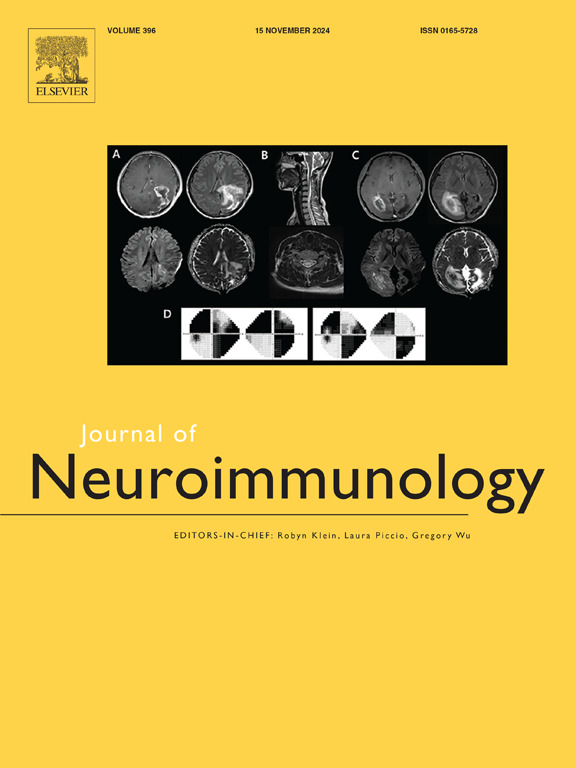Toxocara canis-originated recombinant C-type lectin improves the disability scores of experimental autoimmune encephalomyelitis in murine in vivo models
IF 2.5
4区 医学
Q3 IMMUNOLOGY
引用次数: 0
Abstract
Background
The recombinant C-type lectin protein (r-CTL) derived from Toxocara canis larvae is thought to play a role in promoting regulatory T cell-dominant immune responses in toxocariasis. This study aimed to highlight the therapeutic potential of the r-CTL protein in improving the disability scores of EAE by enhancing the Foxp3+-CD25+ T cells population.
Methods
The r-CTL was expressed in prokaryotic systems and purified using Ni-NTA spin columns. Balb/C57 mice were divided into six groups, with EAE induced in four of them, excluding the healthy control group and the group receiving only r-CTL treatment. Group I (n = 10) received r-CTL treatment post EAE induction, Group II (n = 10) underwent EAE induction only, Group III (n = 5) received treatment with E. coli lysate proteins containing E. coli BL21 and plasmid pET32a without r-CTL after EAE induction, Group IV (n = 5) received sterile PBS after EAE induction, Group V (n = 5) served as the healthy control group, and Group VI (n = 5) received only r-CTL treatment.
Results
The study's findings revealed that r-CTL treatment significantly decreased disability scores in EAE-induced mice. There was a notable increase in the population of CD4+, CD25+, FOXP3+ regulatory T cells following r-CTL treatment. The gene expression levels of IL-10, FOXP3, and GATA3 were significantly elevated in the r-CTL treated group, while the expression of T-bet and RORγ genes was reduced. Treatment with r-CTL significantly mitigated cell infiltration and demyelination in both the spinal cord and brain.
Conclusion
In conclusion, the observed improvements in disability scores in the EAE mouse model suggest that r-CTL protein could be a potential new treatment approach worth further investigation.

源自犬弓形虫的重组c型凝集素改善小鼠体内模型中实验性自身免疫性脑脊髓炎的残疾评分。
背景:来自犬弓形虫幼虫的重组c型凝集素蛋白(r-CTL)被认为在促进弓形虫病的调节性T细胞显性免疫应答中起作用。本研究旨在强调r-CTL蛋白通过增强Foxp3+-CD25+ T细胞群来改善EAE残疾评分的治疗潜力。方法:在原核系统中表达r-CTL,利用Ni-NTA自旋柱纯化。Balb/C57小鼠分为6组,除健康对照组和仅接受r-CTL治疗组外,其余4组均诱导EAE。ⅰ组(n = 10)在EAE诱导后进行r-CTL处理,ⅱ组(n = 10)只进行EAE诱导,ⅲ组(n = 5)在EAE诱导后用含有大肠杆菌BL21和pET32a质粒的大肠杆菌裂解液蛋白处理,不进行r-CTL处理,ⅳ组(n = 5)在EAE诱导后用无菌PBS处理,V组(n = 5)为健康对照组,ⅵ组(n = 5)只进行r-CTL处理。结果:研究结果显示,r-CTL治疗可显著降低eae诱导小鼠的残疾评分。经r-CTL治疗后,CD4+、CD25+、FOXP3+调节性T细胞数量显著增加。r-CTL处理组IL-10、FOXP3、GATA3基因表达水平显著升高,T-bet、RORγ基因表达水平降低。用r-CTL治疗可显著减轻脊髓和脑的细胞浸润和脱髓鞘。结论:综上所述,观察到的EAE小鼠模型残疾评分的改善提示r-CTL蛋白可能是一种潜在的新的治疗方法,值得进一步研究。
本文章由计算机程序翻译,如有差异,请以英文原文为准。
求助全文
约1分钟内获得全文
求助全文
来源期刊

Journal of neuroimmunology
医学-免疫学
CiteScore
6.10
自引率
3.00%
发文量
154
审稿时长
37 days
期刊介绍:
The Journal of Neuroimmunology affords a forum for the publication of works applying immunologic methodology to the furtherance of the neurological sciences. Studies on all branches of the neurosciences, particularly fundamental and applied neurobiology, neurology, neuropathology, neurochemistry, neurovirology, neuroendocrinology, neuromuscular research, neuropharmacology and psychology, which involve either immunologic methodology (e.g. immunocytochemistry) or fundamental immunology (e.g. antibody and lymphocyte assays), are considered for publication.
 求助内容:
求助内容: 应助结果提醒方式:
应助结果提醒方式:


